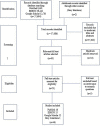Successes and obstacles in implementing social health insurance in developing and middle-income countries: A scoping review of 5-year recent literatures
- PMID: 36388320
- PMCID: PMC9648174
- DOI: 10.3389/fpubh.2022.918188
Successes and obstacles in implementing social health insurance in developing and middle-income countries: A scoping review of 5-year recent literatures
Abstract
Social health insurance (SHI) is a form of health finance mechanism that had been implemented in many countries to achieve universal health care (UHC). To emulate the successes of SHI in many developed countries, many developing and middle-income countries (MICs) have attempted to follow suit. However, the SHI implementation has problems and obstacles. Many more obstacles were observed despite some successes. This scoping review aimed to study the various developments of SHI globally in its uses, implementation, successes, and obstacles within the last 5 years from 2017 to 2021. Using three databases (i.e., PubMed, EBSCO, and Google Scholar), we reviewed all forms of articles on SHI, including gray literature. The PRISMA-ScR protocol was adapted as the guideline. We used the following search terms: social health insurance, national health insurance, and community health insurance. A total of 57,686 articles were screened, and subsequently, 46 articles were included in the final review. Results showed that the majority of SHI studies were in China and African countries, both of which were actively pursuing SHI programs to achieve UHC. China was still regarded as a developing country. There were also recent experiences from other Asian countries, but only a few from South America. Implementing SHI to achieve UHC was desirable but will need to consider several factors and issues. This was especially the case in developing and MICs. Eventually, full UHC would only be possible with a combination of general taxation and SHI.
Keywords: community health insurance; developing countries; low and middle income countries; national health insurance; social health insurance; successes and obstacles.
Copyright © 2022 Jamal, Abdul Aziz, Aizuddin and Aljunid.
Conflict of interest statement
The authors declare that the research was conducted in the absence of any commercial or financial relationships that could be construed as a potential conflict of interest.
Figures
References
-
- Abrejo FG, Shaikh BT. Social health insurance: Can we ever make a case for Pakistan? J Pak Med Assoc. (2008) 58:267–70. - PubMed
Publication types
MeSH terms
LinkOut - more resources
Full Text Sources
Medical



